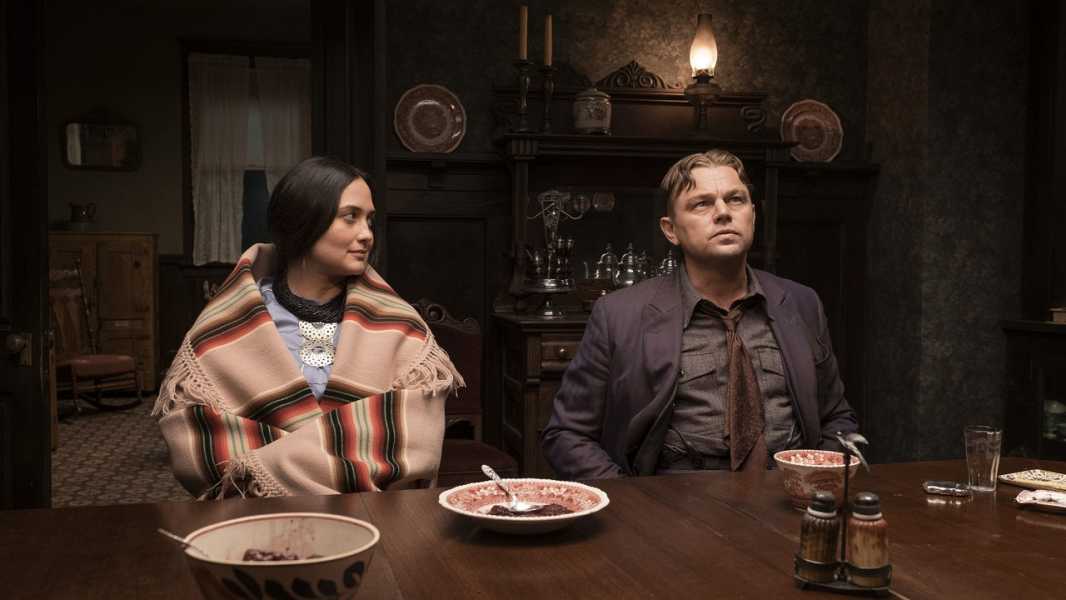
Save this storySave this storySave this storySave this story
Two movies ago, Martin Scorsese made a long-cherished project called “Silence,” and it’s no accident that the center of his new film, “Killers of the Flower Moon,” is silent. To be sure, “Killers” is full of talk; when I interviewed Scorsese about the movie, he mentioned that its star, his longtime collaborator Leonardo DiCaprio, “likes to speak in films,” and Scorsese certainly grants him his wish. Nonetheless, the movie pivots on one of the great wordless gestures in recent movies—indeed, silence both runs through the action like a poison and serves as its own antidote. There’s a way of looking at this movie, a colossal tale of the sociopathy of American history, that’s a matter of listening to what’s said and what isn’t. The movie raises the idea of silence to a nearly transcendent pitch of passion.
Scorsese’s film is an adaptation of a nonfiction book of the same title by David Grann, a staff writer at The New Yorker. The story is centered on the Osage Nation, in Oklahoma, in the late nineteen-tens through the mid-twenties. The Osage had struck oil on their land and had become rich, but the entire civic order of the area—business, politics, social life, law and its enforcement—was organized to pry the money away from the Osage and get it into the pockets of whites. On a grand historical scale, “Killers” brings to light a horrific and shameful episode far too long hidden from view in mainstream, white-centric American culture. Like other films by Scorsese, including “Mean Streets,” “Raging Bull,” “Goodfellas,” “Casino,” and “The Irishman,” “Killers” is also a gangster movie that dramatizes the spread of corruption at a personal level, like a virus, from criminal kingpins to more or less everyone in their purview. It’s also, crucially, a marriage story, and this element shifts the movie’s perspective vertiginously—transforming a tale of collective and individual crime into a vision of love that is mysterious, almost religious, and ultimately terrifying.
The movie’s protagonist, Ernest Burkhart (DiCaprio), is both blandly ordinary and an archetypal figure: an American Everyman, a Forgotten Man, and a Man from Nowhere. He arrives in Fairfax, Oklahoma, soon after his discharge from military service in the First World War. Still in uniform, he has no stated ambition but to make money, no special skill to market, no background to tie him down, and no discernible gains from his time in the Army. (Serving as a cook, he saw no combat but merely its results.) He comes in with the expectation that his uncle, William Hale (Robert De Niro), a local big shot, will find him work. William is a wealthy rancher, treated by the Osage as a white grandee—his nickname is King—and he is another classic American type: a con man, a respectable predator passing himself off as a pillar of the community. He takes the idea of getting his nephew a job a step further: he wants Ernest to marry an Osage woman and then to help do away with her relatives and, ultimately, with her, in order to inherit their oil money.
King—we’ll call him what Ernest does, a moniker befitting his delusions of grandeur—even has a wife picked out for Ernest, a young Osage woman named Mollie Kyle (Lily Gladstone). Ernest is handsome (he is, after all, played by DiCaprio) and jovially seductive, and he courts Mollie assiduously. The problem is that Ernest isn’t just going through the motions; he loves Mollie. All the worse for her, she loves him, too. Despite his love, he’s coaxed and coerced by King into a series of schemes to eliminate Mollie’s sisters and anyone else standing in the way of profit—even, prospectively, Mollie herself. (She’s diabetic, and her infirmity renders her vulnerable to medical chicanery.) Mollie’s health soon starts to deteriorate, but, meanwhile, she is shaken by the unexplained deaths of so many members of her Osage community, and by the utter indifference of local law enforcement—entirely white-run, needless to say. In desperation, she travels to Washington, D.C., to seek federal involvement, which ultimately arrives in the person of Tom White (Jesse Plemons), an agent from the forerunner of the F.B.I., the Bureau of Investigation.
A brief synopsis of the action in this teeming movie, nearly three-and-a-half hours long, gives some sense of its huge dramatic stakes, both intimate and historical. But just as important to the movie’s reckoning with those stakes is its affect—the point of view that it incarnates and the emotions that it stokes. Scorsese’s control of form and tone, and the bold yet subtle way that he marshals incident, signal that he is intent not merely on narrating history but on troubling the conscience of his (doubtless largely white) audience. Like Grann’s book, the movie seeks to acknowledge and correct the silencing of crimes of the past and to force a collective confrontation with a moral and political tragedy and its unresolved legacy.
“Killers” moves at a breathless pace, marked by jolting elisions and sudden turns of events, evoking the web of evil into which Ernest is quickly, if imperceptibly, drawn. Scorsese intently observes the arachnid manner with which King turns Ernest from outsider to insider, which is accomplished in the insidious span of a single welcoming conversation. The rapidity with which Ernest, without a glimmer or a flicker of self-awareness, is drawn into petty crime and then into murderous schemes, suggests an existential vortex of normalized depredation. As the schemes become ever more brazen and complex, and as the pool of victims widens and deepens, Scorsese looks on, with horrified astonishment, at this microcosmic display of the American way of life—at what the ruthless dare if they are sure of getting away with it. There’s a scene at a movie theatre in which a newsreel of the 1921 Tulsa Race Massacre is shown, and a line of dialogue emphasizes that the killings in Fairfax are “just like Tulsa.”
The entire milieu of Osage territory’s white residents emerges as, in effect, one large gangland. As ill-gotten money and undue power flows through this community of interlopers, complicity is inevitable, and no one has clean hands. Even a side character, the aging and sluggish John Ramsey (played to fascinating effect by Ty Mitchell), can’t avoid running errands for the big man, but what primes him for grave evil is a trait that implicitly undergirds the entire local order: racism.
In the case of Ernest, a blank slate, the lesion through which contamination takes hold is his blankness—his rootless need to belong, his lack of clear purpose, his gratitude to his uncle for handing him an identity, a life. Yet, even as his inchoate desires are awakened, energized, and weaponized, Ernest is both more than just another profiteer and less; he’s a blank of another kind, blank to himself. With his gee-willikers charm comes a kind of puerile—no, infantile—ignorance. Ernest is perfectly innocent and perfectly guilty, simple enough to know he’s doing wrong and unreflective enough not to doubt it’s the right thing to do. He isn’t so much a Jamesian central consciousness as he is a central block of unconsciousness, without a shred of insight; he’s a figure of naïve American contradiction whose sole glimmer of redemption is his love for Mollie, in his recognition of her nobility of character. (“She’s a lady” is the way he puts it.) The movie largely follows Ernest, and thereby calls viewers into complicity with his stunted and benighted perspective, denying them a way out of their own association with the system of depravity that sucks him in.
In the courtroom drama that occupies the later part of the movie, Ernest is offered a chance to avow his misdeeds and to help bring down the system of organized crime that gave rise to them—to bear witness in the official sense. But the more crucial confession is the one that he can make to Mollie, and that’s where the moral pressure of the story reaches its maximal, almost mind-bending peak of power. Ernest may be the protagonist, but Mollie is the central character. Scorsese calibrates her place in the film with a delicate sense of form. She is not only the character on whose actions the drama pivots but also the one whose subjectivity, presented sparingly but suggested powerfully, gives the story a sense of inner life.
That said, the film does not presume unrestricted access to Mollie’s thoughts and feelings. Scorsese films her—and the Osage community over all—with a modest sense of distance, altogether aware of his position as an outsider, albeit a sympathetic one. He depicts Osage life with candid admiration matched by self-restraint, presenting religious ceremonies with an earnest appreciation of their spiritual aesthetic and depicting realms of dreams and visions with unadorned clarity. He presents the political organization of the Osage Nation with attention to its democratic openness even in the face of exclusion from state and local politics, even unto its regrettably trusting admission of such faux-benevolent outsiders as King. But, above all, he depicts Mollie as a heroine both of principled action and of exalted feeling—and he does so mainly through her sheer presence, as embodied by Gladstone and brought to life in her performance.
In “Killers,” Mollie knows and feels far more than she says, and the depth of her insight is concentrated in Gladstone’s fixed and relentless gaze. The movie doesn’t explain what Mollie is thinking while her sisters are dying young, or while she’s getting sicker during Ernest’s treatments. It doesn’t explain what Ernest thinks when he’s first put up to nonviolent crime and then is dispatched on lethal errands. The character psychology of “Killers of the Flower Moon” is minimal—because Scorsese instead presses its action furiously, urgently, onto the screen as if it were something like a dramatized documentary in the first person, his own bearing of witness. The confrontational political view of American life that he unleashes in his previous film, “The Irishman”—a furious work made in furious times and, like this one, a film with silence at its core—here reaches even more deeply into the core of national identity, and into Scorsese’s own self-image.
The silences that Mollie brings to bear, through Gladstone’s performance, on the horrific and outrageous doings are mightily reverberant, reminiscent of the silent testimony to horror that Anna Paquin performs in “The Irishman,” playing a gangster’s daughter. But there’s a crucial difference: in “Killers,” Mollie isn’t the miscreant’s daughter but his wife. Scorsese presents the marriage story, the story of love, as an absolute—something that is set apart from cultural, historical, and political particulars and that has the supreme power of religious faith. It is a commitment that extends even to extremes of self-abnegation and self-sacrifice, and that resounds with a fearsome silent thunder when that faith is renounced. The scene of that break is among the most devastating in Scorsese’s career. It’s all the more spectacular for its restrained, even introverted simplicity, and for what follows—a scene of self-conscious irony regarding Scorsese’s own uneasy position of telling such a story, of bearing such witness, in such an inappropriately carnivalesque setting as the American entertainment business. Scorsese, as you may have heard, gives himself a notable cameo, and the last word—compelled to speak, compelled to bring history to light, at whatever spiritual risk of his own. He, too, is involved. ♦
Sourse: newyorker.com






